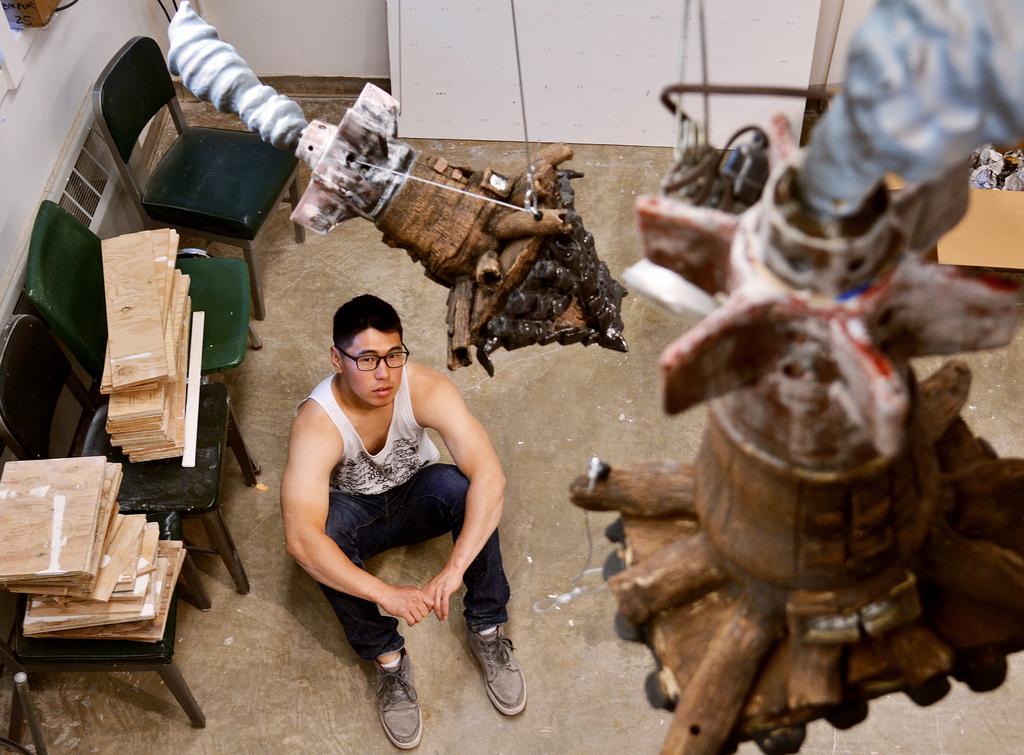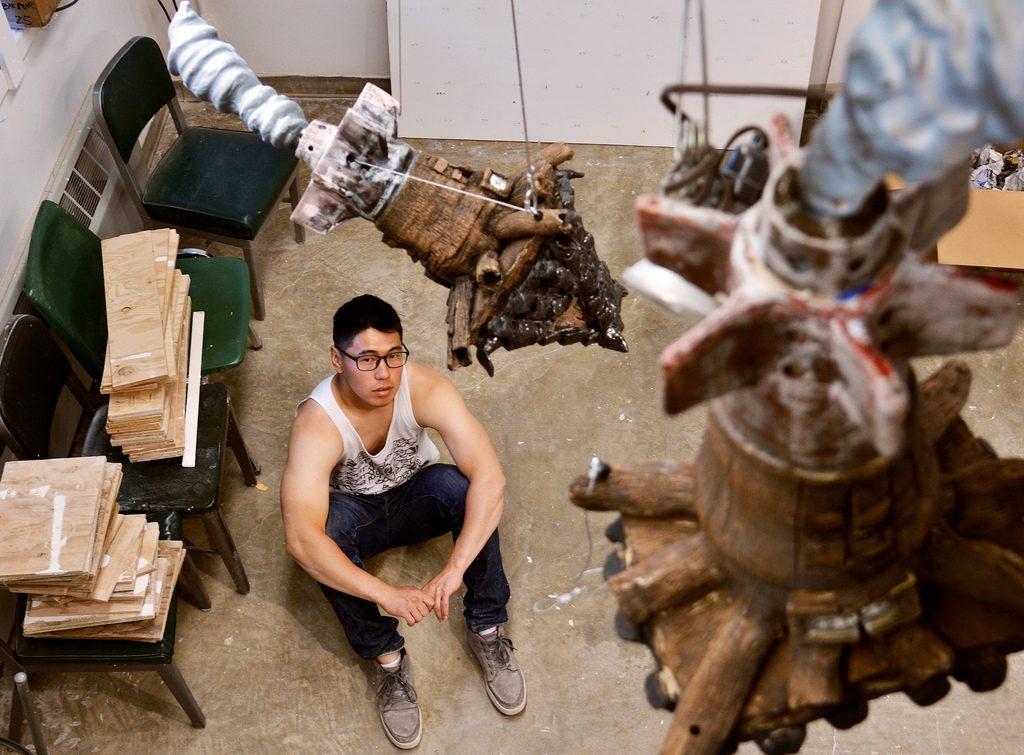
A young man in clay-smudged jeans sits on a stool, steps on a pedal and molds a heap of clay with quiet finesse. The wheel spins the now curvy tower of clay like the gears turning in his head. He asks, “What would you like me to make?”
The tower is cut with a wire and reassembled into the lid, bowl and spout of a teapot. The rest is manipulated into a tall vase.
This is 27-year-old studio art major Nick Oh’s nature as an artist — calm, skilled and prolific. Although he’s described by classmates as mysterious and keeping to himself, his art speaks volumes.
Oh’s most ambitious piece, the slightly larger than life-size figure of himself — sitting cross-legged nude and eating American items (a football and McDonalds cup) out of Chinese take-out boxes — features about 300 racial slurs and jokes painted on the bare “skin” fired with a clear glaze.
The sculpture is a vulnerable expression of Oh’s identity crisis. He is caught between two cultures.
“Nick’s art has a very heavy grounding in his culture as a Korean American. I understand that (from) a lot of the aesthetic qualities in his pieces,” his classmate, Michael Grejsen, said.
At 15, Oh moved from Kyoung Ju, South Korea to Eugene, Oregon with his parents and brother. His dad was an exchange professor at University of Oregon.
“(I) moved to Oregon, (which has a) majority white people. I didn’t speak any English. I had a hard time fitting in, trying to assimilate to a different culture,” Oh said.
He admits he would listen to ‘N Sync’s “Bye, Bye, Bye” to understand the meaning of the popular lyrics and watch movies with simple dialogues, like “Spiderman,” to learn English. Oh, like his self-portrait, became a consumer of American pop culture to assimilate. While he struggled to fit in, there was one thing that came easily.
“When I came here I wasn’t really good at anything really, except for art. It helped me connect to people,” he said.
Oh has stuck to art ever since. Introduced to ceramics just two years ago at SF State, he will graduate this spring naming ceramics as his emphasis.
“His art is concerned with Asian American issues, which isn’t new to us (SF State’s art department), but it’s expressed in a contemporary way,” said Jeff Downing, an SF State art professor.
Most of his sculptures allude to the Asian stereotypes and jokes he encountered later in high school. Oh, on several occasions, has been asked if he is North Korean, understanding fully the implications connected. He displays his stereotype in a series of “bomb houses.” The top is a tiled pagoda-like roof, with a bottom of fins like those on weapons of mass destruction.
“If something (a nuclear attack) happens in Korea, I still feel prideful that we’re (South Korea) still defending our ground,” Oh said. “I look at how the Americans view the conflict: The Koreans are a threat.”
Oh is serving an ongoing five years in the Marine Corps. Currently in the reserves, he decided to join at 22 because of Korean traditions of military conscription. He finds it a paradox to be defending a country that believes he is a threat.
No doubt, Oh will keep creating and sharing the complexities of his dual identity. He hopes to attend graduate school for art and eventually teach, but has reservations, given that he’s 27 and never expected to still be in school.
“You never know what will happen in life. Just the mysteries in life, I guess,” Oh said.
It was a surprise to Oh that the expression of his story would be through art, but it has made people listen. His self-portrait was spotted at a gallery in Davis and recently sold for $600.








Alyssa Fazio • May 15, 2013 at 12:20 pm
Acculturation, or learning the values and customs of a host culture, is prevalent in the minds of immigrants, whether they know it or not. Steven Heine focuses on acculturation strategies in his book, Cultural Psychology. He shares that John Berry and his associates found that an immigrant’s participation in their host culture and maintenance of their heritage culture influences an immigrant’s attitude toward their host culture and toward their heritage culture, respectively. I disagree that Oh’s sculpture is a “vulnerable expression of [his] identity crisis” and that he is “caught between two cultures”. While contradictory, his ceramic piece of himself painted with racial slurs eating American things out of Chinese take-out boxes seems like the familiar acculturation strategy of integration. Integration is characterized by high attempts to participate in the host culture while maintaining traditions of the heritage culture. Oh mentions that he listened to popular American music and watched American movies in an effort to learn English and assimilate when he first came to America from South Korea. His South Korean heritage, as well as his American lifestyle, is incorporated in his art. It was how he connected with others in a new country when he felt like he couldn’t fit in. Having elements of both South Korea and America, his ceramic piece beautifully integrates the two countries that represent him. He serves in the Marine Corps while still having pride for his home country. Nick Oh is presented here as a well-adjusted, South Korean immigrant living in America. His sculpture has underlying messages, but should really be viewed as a healthy portrayal of his cultural self rather than a “vulnerable expression of [his] identity crisis”. He isn’t “caught between two cultures”, but rather he is holding them in his hands and molding them into art.